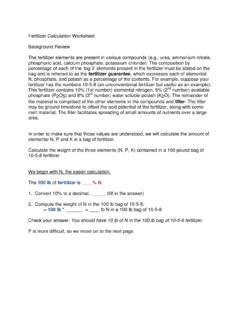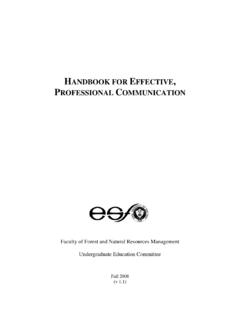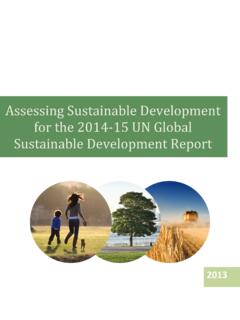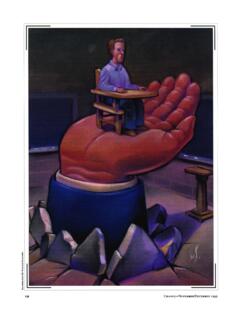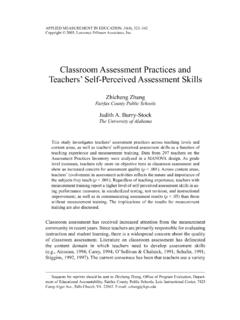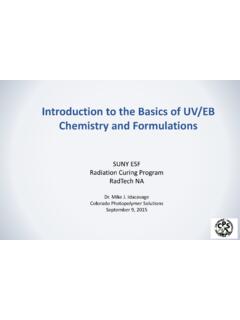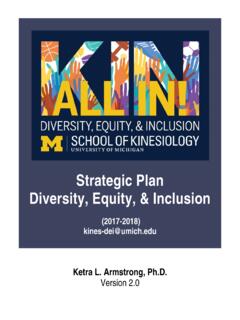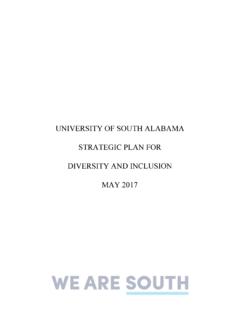Transcription of Inclusion, Diversity and Equity Strategic Plan Fall 2016 ...
1 inclusion , Diversity and Equity Strategic plan Fall 2016 College inclusion , Diversity and Equity Committee 2 Members of College inclusion , Diversity and Equity Committee: Sarita Bassil Robin Kimmerer Scott Blair Michael Klaczko Tim Blehar Anne Lombard Kelley Donaghy Matt Potteiger Heather Engelman Susan Sanford Annette Hightower Timothy Volk (Claire please add titles to everyone above) 1 A choir singing one part in unison can make beautiful music, but the magic is multiplied with the inclusion of the harmonies that complement the melody and add fullness to the sound, and those parts that at times provide discordance to challenge the expected. This is why all voices need to be at the table.
2 --Dr. Nancy Barbour, 2016 Feinstone Award Recipient, closing statement, 10/26/16 I. An Introduction to inclusion , Diversity , and Equity at ESF In April 2016, the State University of New York College of Environmental Science and Forestry (ESF) launched its first college-wide committee focused on Equity and inclusion at the college. One of its first actions was developing an inclusion , Diversity & Equity Strategic plan . Through implementation of this plan , ESF will continue to be a leader in the study of science, engineering, design, policy and management related to the environment and achieves this goal by becoming a more inclusive institution to meet the challenges faced in an ever-changing world.
3 In addition, by joining the State University of New York s system-wide Strategic focus on Diversity , we engage with a robust system of colleges and universities united in building a more supportive and inclusive environment for students, faculty, staff, administrators and alumni to engage in dynamic fields of study. Connecting with our college community to develop a dynamic Diversity Strategic plan was of the utmost priority of the ESF College inclusion , Diversity & Equity Committee. By creating three different rounds of listening sessions and numerous individual and small group presentations across campus, our committee is proud to have been able to partner with a wide array of student groups, faculty and staff colleagues and alumni in building a college-wide dialogue.
4 In addition, using Diversity plans for institutions such as Penn State University, Michigan State University, Cleveland State University, and the SUNY Campus Guide for Strategic Diversity & inclusion plan allowed our committee to develop a document founded on the good work of others that is specific to ESF. We look forward to partnering with our colleagues across the College to implement the plan to attain our overarching goal of creating a more inclusive , diverse and equitable community. 2 A. Mission and Vision The SUNY College of Environmental Science and Forestry is committed to creating and sustaining a diverse community that promotes Equity and inclusion for all its members. Diversity that arises from differences such as, but not limited to, gender, race, ethnicity, ability, sexual orientation, socioeconomic status, national origin, or religious traditions is central and indispensable to the institutional excellence and mission of the College.
5 We, as the College of Environmental Science and Forestry, will achieve a diverse, equitable, and inclusive community by eliminating barriers to full participation in curricular, co-curricular, and workplace environments, and promoting the SUNY and ESF institutional structures, practices, policies, and spaces that respect, value, and support differences through inclusive excellence. inclusive excellence is our on-going commitment to recognizing that success is measured by how well a community values, engages, and embraces a rich Diversity of ideas and people. B. plan Development - History of Diversity and inclusion at ESF ESF is highly focused on the study of sciences, design, engineering and management of our global environment and natural resources.
6 The college enrolls just over 2,400 students enrolled at the college from undergraduate students to graduate level doctoral students. Approximately half the students and 30% of the faculty are female with about one-third of the total student body comprised of graduate students. Approximately 40% of incoming undergraduate students transfer to ESF from other institutions. ESF began as an all-male, predominately white institution in 1911. There were no women students during the early decades and by 1969, women comprised of enrollment. "The early 1970s saw the first female trustees appointed to the board. The first woman graduated from the Ranger School in 1974.. A woman's [Woodman] team was begun in 1973 and won an international competition in 1975.
7 And by 1974, an affirmative action program was underway at ESF to increase minority recruitment. In 2011, 40% of the 2,200 enrolled students were female (Centennial Celebration Display in Moon Library). 3 Beginning in 1978 ESF was an exclusively upper-division college before it officially resumed educating freshmen and sophomores in 1990 with an incoming class of 50 first-year students. Once the college returned to enrolling full undergraduate classes, the Office of Undergraduate Admissions began actively recruiting students of color. These students founded the college s Baobab Society ca 1991, under the advisement of Admissions Counselor Mrs. Eva Williams, to ensure the multicultural outreach and enlightenment of the college and Syracuse communities.
8 [It] host several events throughout the academic year to celebrate the many different cultures represented at the SUNY College of Environmental Science & Forestry. The Office of Multicultural Outreach grew from these institutional and student initiatives into a one-woman (Dr. Carmen McCoy-Harrison) office housed in the Division of Student Life and reporting to the Vice President of Student Affairs in 1999. Its Director maintained a hand in enrollment, but primarily provided support mechanisms for students on campus. Following McCoy-Harrison s untimely death, the office was restructured to center on issues internal to the college, rather than outreach which implied efforts focused off property.
9 In 2004, the renamed Office of Multicultural Affairs was moved within the Office of Instruction and Graduate Studies under the Vice President of Academic Affairs. Student and faculty support remained a priority of the office, but program development to enhance Diversity across campus was anticipated. The Office s best-known programs were the Collegiate Science and Technology Entry Program and a Lunchtime Learning series, which invited the college community to reflect on the natural environment from different cultural perspectives. Director Dr. Raydora Drummer enjoyed the dedicated and paid assistance of one half-time employee (C-STEP) and three graduate mentors. She was also guided by a Diversity Council comprised of students, faculty and staff, until the Council was disbanded in approximately 2008.
10 Despite the move of the office, in 2014, its primary focus remained on students, rather than on the faculty and staff that also shape their ESF experience. The Office lost momentum with the extended leave of the Director in 2013, although the addition of a half-time temporary Coordinator (Ms. Nory Mitchell) backfilled student support for the semester of spring 2014. A summer 2014 search for a full-time Coordinator was closed and thus the position unfilled due to a hiring freeze initiated after interviews. 4 During the time the Multicultural Affairs office sat vacant, students and alumni searched for support on their own. The bylaws of the Undergraduate Student Association first referenced its own Director of Student Affairs and Diversity position when amended September 9, 2013.

